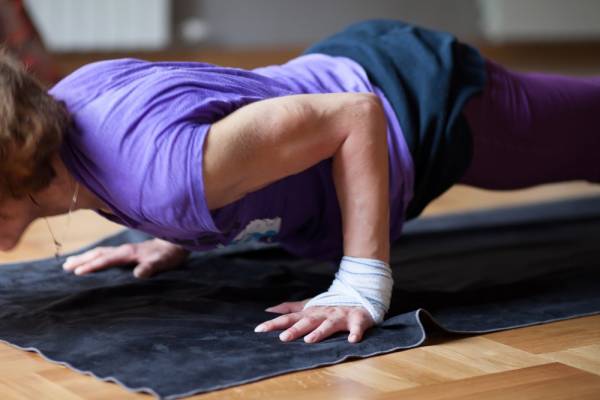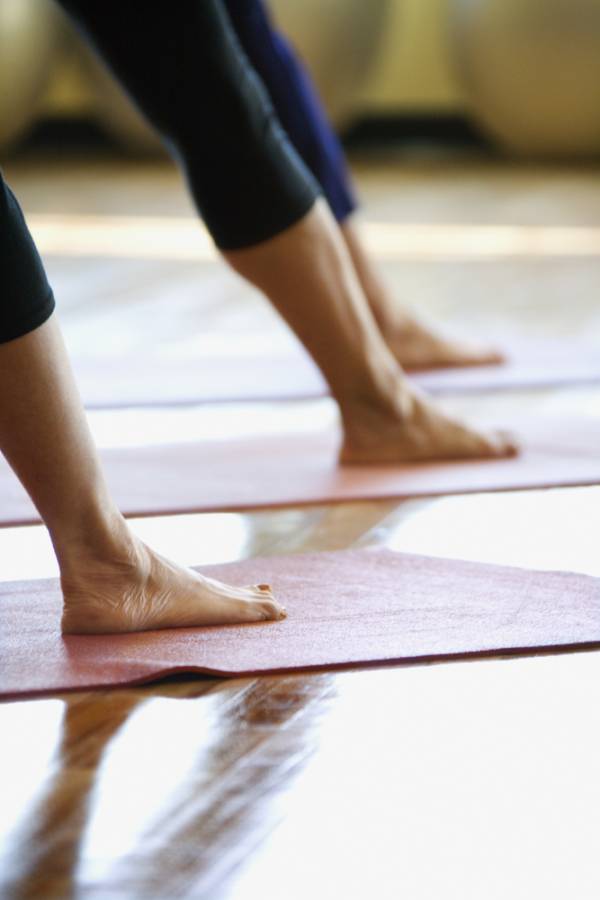A year ago, I made the mistake of joining the team at a CrossFit gym and teaching yoga to athletes. I should have been teaching yoga for athletes. There is a big distinction. Would you take a super-flexible yogi who has never lifted a weight and throw him into an Olympic weightlifting class? No, because there is too great a risk of injury with someone that flexible. The same applies for yoga. When someone is very strong, that person also tends to be very tight, and yoga can pose great risk for injury to that person.
That is a controversial opinion, but I believe we are recognizing more and more how yoga can harm and not help when applied incorrectly. In my personal experience, as I guided students through flow classes, I watched fewer and fewer show up each week. Increasingly, they were complaining of shoulder discomfort in class, and I noticed they just were not able to do one of the staples in my class – downward facing dog. This was hard for me; I knew these people were athletes who wanted to work hard and sweat. I feared if I took it too easy, they would all stop coming to yoga. But, as my teacher always says, “Give them what they truly need. Not what they think they need.”
This is such an important distinction when working with athletes. Athletes tend to be very type A, task-driven, adrenaline addicted folks. I can say this because I myself am a former collegiate athlete and total sweat junkie. It is hard for me to step back, say no to my ego, and start honoring what is in my highest purpose on my yoga mat. Often, the thing I need most is what I want to do the least. I started teaching my CrossFit athletes with this same guiding principle. Admittedly, some did stop attending. However, others began showing up, asking questions about their bodies and injuries, and touting the importance of mobilizing to their peers.
Here are two big differences I apply when teaching yoga for these athletes:
1. Shoulder Mobility vs. Shoulder Strength
 Rather than shoulder strength, with athletes I work on shoulder mobility. In most regular yoga classes, we are working to increase shoulder strength. The shoulder is the most mobile joint in the body. Because of this, it needs to be reinforced and strengthened in order to keep it safe and functional. Athletes are already doing this. Most of my athletes have overdeveloped traps and delts, and all of their overhead lifting has taken its toll on the shoulder joint. Many of them have limited mobility and may already be at risk for kyphosis – a rounding of the upper back we typically see late in life. We do a lot of stretching, but we also simply move the shoulders around in their sockets as much as possible.
Rather than shoulder strength, with athletes I work on shoulder mobility. In most regular yoga classes, we are working to increase shoulder strength. The shoulder is the most mobile joint in the body. Because of this, it needs to be reinforced and strengthened in order to keep it safe and functional. Athletes are already doing this. Most of my athletes have overdeveloped traps and delts, and all of their overhead lifting has taken its toll on the shoulder joint. Many of them have limited mobility and may already be at risk for kyphosis – a rounding of the upper back we typically see late in life. We do a lot of stretching, but we also simply move the shoulders around in their sockets as much as possible.
One of my favorite options for this is to “Floss the Shoulder.”
- Start seated with the legs folded into easy pose. Have a yoga strap or band.
- Hold the strap in each hand about the width of your knees when seated cross-legged. This is typically a good starting distance, but you may need to adjust.
- Inhale, keeping the arms straight as possible, begin to lift the arms until the biceps come just behind the ears. Exhale, release back down.
- Inhale, begin to lift again, this time coming back another ten degrees or so. Exhale release back down.
- Continue increasing the circle by about ten degrees until the hands come all the way down behind the back.
- If you are very tight, you may need to take the hands wider on the strap or bend the elbows as the arms make their journey.
- You will find a sticking point each round, breathe into this rather than forcing yourself through it.
- Repeat for 10 to 20 rounds
2. Long Holds vs. Flow
A second key difference when I teach yoga for athletes is the emphasis on long holds in order to find proper alignment. Ideally, I would like athletes to learn the functional challenges they face in their bodies and take this with them into the gym. For example, many of my athletes turn their feet out slightly, dip their lower back too much, or allow the shoulders to disengage from the sockets. By working on these functional alignment cues in yoga, they gain better awareness for their next lifting session. Simply put, I don’t teach power or flow yoga to athletes.
Yes, there are elements of flow when we move the shoulders, wave the chest up and down, circle the hips or otherwise mobilize the joints. But, we don’t flow in and out of key poses like Warrior II. Instead, if we do any of these poses at all – and we don’t always as these are strength-building as well as mobilizing poses, and most of my athletes don’t need any more strength building – we hold and focus on the subtle sensations in the body. We ask questions like:
 How are my feet? Are they turned out or in, and do I need to make a correction?
How are my feet? Are they turned out or in, and do I need to make a correction?- How are my knees? Are they directly over the second toes, or are they rotating one direction or the other or sticking out beyond the ankle? Can I adjust this?
- How are my hips? Does all of my rotation start from the hip and travel down the leg? If not, can I more effectively rotate the hip to keep a kinetic chain in the leg?
- Is my low belly supporting my low back? Are my low back long and my upper back mobile?
- Are my shoulders strongly released into their sockets? Are my traps relaxed?
- Is my chest open with broad collarbones?
These are just a few things we can look at. In most yoga poses, the above questions will apply. Once we find alignment in the body, we hold and work on isometric movement. Only after several breaths do we mindfully exit the pose.
If you are an athlete who also happens to be a yogi – i.e., if you know how to correct your alignment in each pose – it is much safer for you to step into a flow class. But if you’re looking to yoga for the first time or to help heal and prevent injuries, take it slow! Yoga holds tremendous power to heal the body and mind, but like any form of exercise it can also harm. You work hard to develop peak performance in your body. Don’t throw it away just so you can get sweaty in yoga..
Photos courtesy of Shutterstock.






